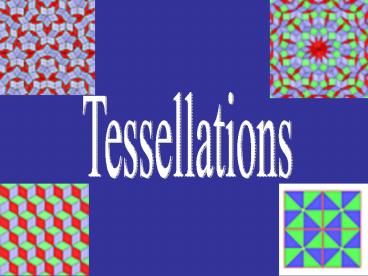Tessellations - PowerPoint PPT Presentation
Title:
Tessellations
Description:
Title: Slide 1 Author: mjtrent Last modified by: Diane Royer Created Date: 3/22/2004 4:55:48 PM Document presentation format: On-screen Show (4:3) Company – PowerPoint PPT presentation
Number of Views:250
Avg rating:3.0/5.0
Title: Tessellations
1
Tessellations
2
Tessellation Repeating geometric design that
covers a plane with no gaps or overlaps.
3
REGULAR TESSELLATIONS RULE 1 The
tessellation must tile a floor (that goes on
forever) with no overlapping or gaps. RULE
2 The tiles must be regular polygons - and all
the same. RULE 3 Each vertex must look the
same.
What's a vertex?
where all the "corners" meet!
4
Vertex
60
60
60
360 degrees
60
60
60
5
What can we tessellate using these
rules? Triangles? Yep!
Notice what happens at each vertex! The
interior angle of each equilateral triangle is
60 degrees.....60 60 60 60 60 60
360 degrees
6
Squares
What happens at each vertex? 90 90 90 90
360 degrees again! So, we need to use regular
polygons that add up to 360 degrees.
7
Will pentagons work? The interior angle of a
pentagon is 108 degrees. . . 108 108 108
324 degrees . . . Nope!
Hexagons? 120 120 120 360 degrees Yep!
Heptagons? No way!! Now we are getting overlaps!
Octagons? Nope! They'll overlap too. In fact, all
polygons with more than six sides will overlap!
So, the only regular polygons that tessellate are
triangles, squares and hexagons!
8
The Dutch Artist, M. C. Escher was famous for
using tessellations in his art. Here are some
examples of his work
9
(No Transcript)
10
(No Transcript)
11
(No Transcript)
12
(No Transcript)
13
(No Transcript)
14
(No Transcript)
15
(No Transcript)
16
Tessellations can be found in nature and the
world around us.
17
Now, its your turn. You will make 2
tessellations one that translates, and one that
reflects. Both are due on Wednesday.
18
References
http//www.coolmath.com/tesspag1.htm
http//www.thinkquest.org/library/site_sum.html?tn
ame16661url16661/escher.html































